The long view: Reflections on Austin’s drought
The approach of autumn is a hopeful time for the central Texas gardener. It means we’ve survived another long, hot summer and can enjoy being outdoors again. It means time for the rains to return to revitalize the summer-weary garden, replenish our aquifers and lakes, and offer the promise of wildflowers in the spring.
But as the fiery summer of 2011 crackles to a close I’m not sure that we can count on those certitudes this fall. Another La Nina weather pattern means a forecast for a drier than normal fall and winter, followed by another hot, dry summer. As I drive through Austin’s neighborhoods that back up to unwatered greenbelts, I see ghostly live oaks, half defoliated or entirely dead, dropping ancient limbs that had withstood previous centuries’ tests. Seemingly indestructible crepe myrtles are brown and withered. Underbrush is coppery and sere, just waiting for a stray cigarette butt to burst into flame.
The sky has been unrelentingly rainless (today’s brief showers notwithstanding). The LCRA reports that “[t]he 11 months from October 2010 through August 2011 have been the driest for that 11-month period in Texas since 1895, when the state began keeping rainfall records.”
In addition we’ve had record heat. Ronny Bell at The Lazy Shady Gardener recently provided some grim weather statistics:
As of today [9/16/11], we have experienced 85 days with a high temperature at or above 100 degrees. The average yearly number of 100 degree days in Austin, Texas is 13.5 – I’m thinking this year will be pushing that average up quite a bit. The previous yearly record for the most 100 degree days was 69 set in 1925 – that record has been absolutely shattered.
But we who love nature don’t need these facts to tell us something bad is happening. Anyone with eyes can see it in the suffering trees, gardens, and wildlife of our city. You can feel it in your heart.
Why now, one may ask? Why did this drought of record have to occur during my time in Austin? I’m sure some of my clients are asking Why? as they see some of their new drought-tolerant plants suffer and die. Of course, drought-tolerant is far from drought-proof, especially when newly planted, and even experienced gardeners are watching with dismay as established, xeric plantings die off because of the lack of rain. Hitch this existential Why? to the attendant guilt for caring about one’s own little eden when so much more is at peril if we don’t soon get rain, and lots of it, and you have an inkling of the local gardener’s psyche.
Like many Austin gardeners I know, I’ve been moody and sad. I’ve vacillated between despair over the changing landscape, worry for the future of Austin’s drinking water supply (for who can really complain about not being able to water when our fresh-water supply continues to drop alarmingly?), and sorrow for the loss of what ultimately may be thousands of trees that have helped make Austin the leafy, green city I’ve always known.
And yet Austin has endured cycles of drought many times before. My husband’s grandmother once told me about the 10-year drought of the 1950s. “It killed off even the trees,” she remarked solemnly. I couldn’t imagine such a thing at the time, but here we are again. Trees do grow back, though maybe not for the drought survivors to ever see to maturity. However, worse things have happened, and do. We should count our blessings and take the long view.
And so that’s what I’m determined to do from here on out—try to be philosophical and less moody. Not Pollyanna-ish—I don’t believe we’ll be back to our old weather patterns any time soon—but clear-eyed and calm. Plants will die. Eventually we’ll plant new ones that are able to withstand longer periods of drought. We’ll adapt to the new reality. We’ll still hold out hope for our gardens, and for wildflowers in the spring. We’re gardeners. We take the long view.
The photos here are of my front and back gardens, freshly mulched, all the dead plants trimmed out and hauled away, looking pretty good all things considering. I took these “long view” pictures on Friday to record the garden at this moment in time—the survivors of the summer of 2011. And now, here’s to the future and our gardens, come what may.
All material © 2006-2011 by Pam Penick for Digging. Unauthorized reproduction prohibited.


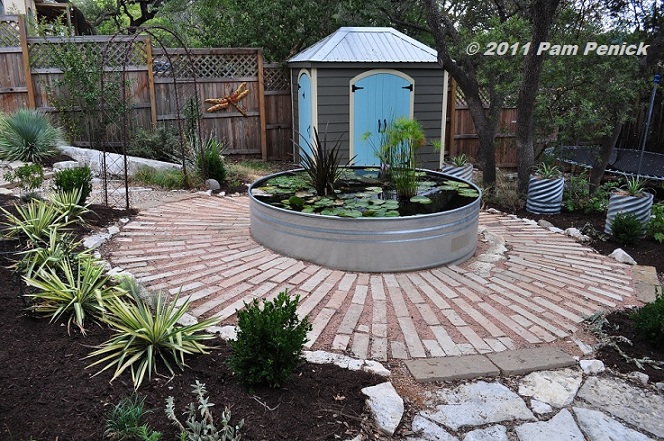
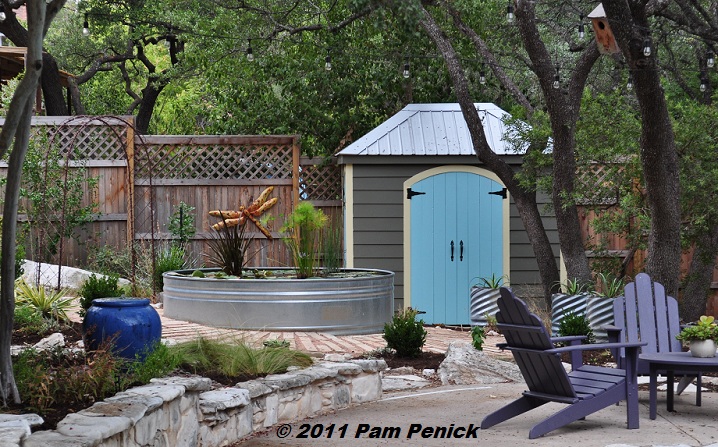
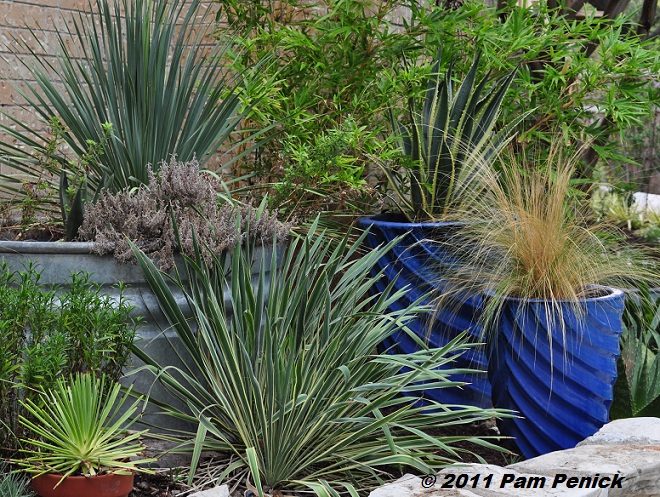
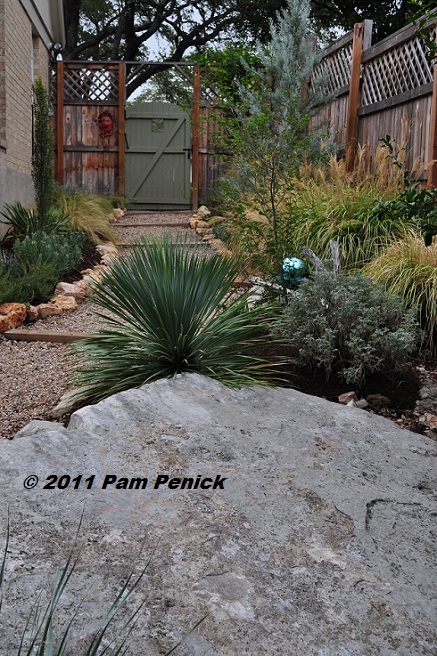
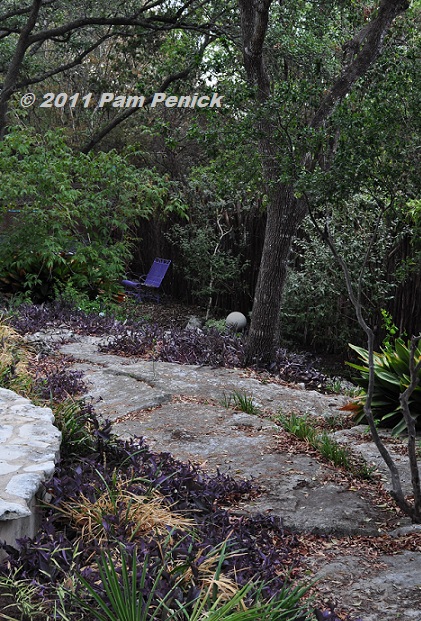
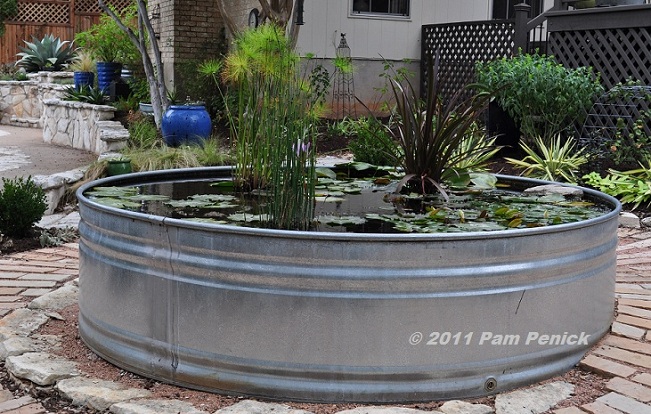
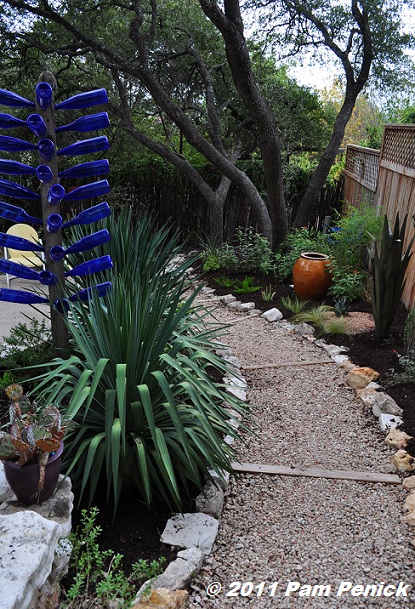
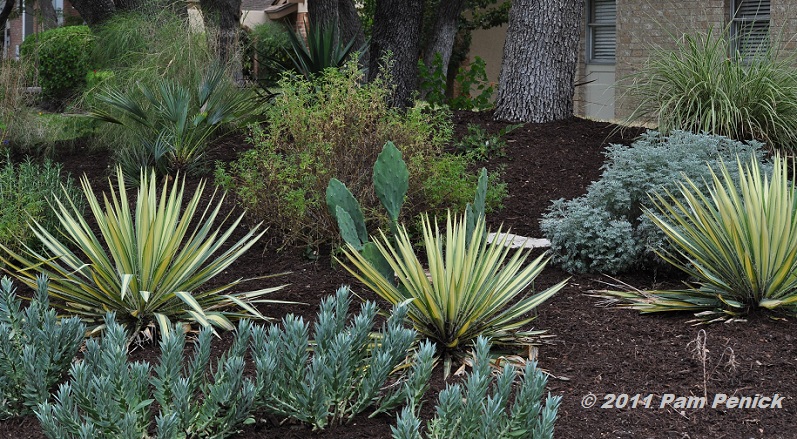
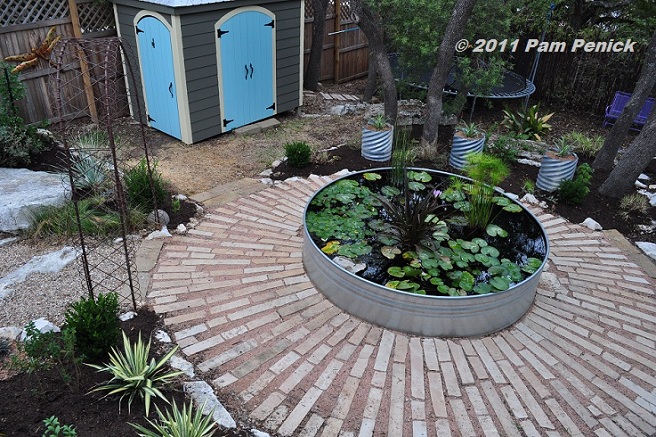
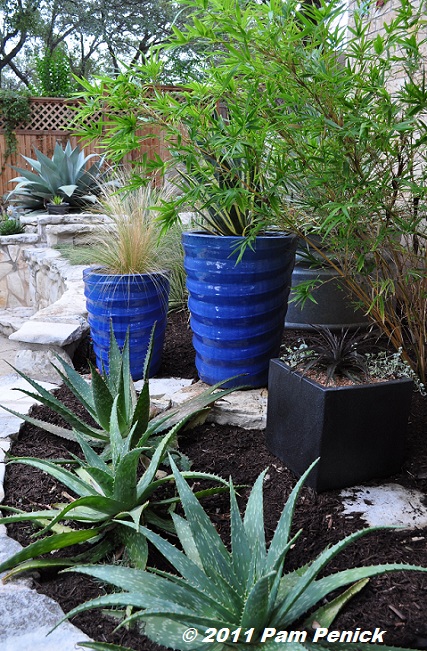
Atta girl! I look forward to being able to talk to people about replacing their lawns and installing rainwater systems without watching their eyes glaze over.
Now that a teensy bit of rain is forecast this week, you might see a lot more interest in rainwater collection systems. —Pam
Your place looks great, and mulch is a good thing! That 1st pic of the yuccas left, and the metal culvert planters opposite, is perfect. Maybe I missed something, but that’s the first time I’ve seen that all in context – perfect!
Thanks, David! I haven’t shown the whole scene before now, but I was intentionally trying to balance the curve of ‘Color Guard’ yuccas on the left with something of similar form and color—and with added height to make up for being on the downhill side—on the right. The elevated trio of squid agaves, which can take the shade in that bed while still being drought-tolerant in containers, did the trick. And the spiraling stripes of the culvert planters complement the stripes of the yuccas opposite. —Pam
Wonderful reflections and thoughts that express my similar feelings about this past summer and trying to fight feeling down when there are so many bigger concerns in the world. The garden is something I can deal with, so learning and moving on with a revised view is the plan.
I’ll be following your changes and new plants with interest as well.
Thank you, Shirley. I think everyone who gardens in Texas has felt some level of despair during this difficult year. I decided to just acknowledge my feelings and try to move on. Our response to difficulties is all we can control. —Pam
Hang in there! You have a great attitude. Adapt to the drought. Collect rainwater and store it for use. Change what you are planting. Here in Arizona we have been in a drought for most of 20 years. Focus on what you can do.
Good points, Sandy. Austin has always seemed to straddle the line between the southeast and the desert southwest. Weather conditions may be moving us more toward the southwest, and if that bears out over the long-term we will be looking to desert gardeners like yourself for our new gardening aesthetic. —Pam
Thanks Pam. I needed that. I really knew most of it, but this summer has been so brutal I had sunk into more despair than hope. And your yard looks very nice! I am trying to clean mine up and plant a few things around the patio. Gardening is all about faith in the future.
Yes, it is. I can’t imagine a life without gardening, so we must keep on keeping on! —Pam
What a great post and pictures, Pam. You have a REALLY beautiful garden, and this comes from someone who isn’t nuts about agaves. After 10 yrs of gardening in the same spot, this year pushed me to face the fact I can’t keep up if the climate changes permanently. My feeling is it will. With the exception of two days, I have watered 2 hours every evening by hand since May. My lawn was not watered at all and is dirt. I have rainwater tanks and rainwater barrels that sit empty. I reuse my wash water. I collect buckets of water from my sink, bathtub, and the dog’s bowl. Everything is heavily mulched but my water/electric bill this month was $550.00 despite the thermostat kept at a constant 85 and the AC turned off completely at night. Bottomline: I try hard. I know I’ve saved my trees but I know I can’t do this forever. It makes me sad but I won’t do this kind of watering next year. I will look toward planting agarita, Turk’s Caps, and others that I know will still be here despite these droughts. FYI – I didn’t water my Turk’s Cap at all till last week and they were okay growing in caliche.
Laura, your story breaks my heart. It really tells the story of what this summer has been like. But you’re right—at some point you can’t keep up anymore with what it takes to keep the garden going. My gut tells me that we’ll be at Stage 3 watering restrictions by the middle of next summer, with nothing allowed but standing with a hose as you have done. At that point we’ll all be assessing the survivors and adding more of those. —Pam
Great post, Pam! I’m almost past the gloomy stage and into the creative, “What next” side of things. Extremely hard freezes and drought these past few years certainly puts a new spin on things.
Yes, the weather extremes have been remarkable, and have required some creative thinking about how to garden here. I look forward to continued inspiration from you and CTG. —Pam
Now I feel guilty for grumbling about the cold rain that has fallen all day and ruined my plans, all of which were to occur outdoors. I will not complain, but will consider myself and my garden as blessed. Though having lived places where the trees help define the local character, I worry about your city’s canopy and hope relief is soon coming. Your positive attitude will serve you well.
I’m trying hard to wrench my head around to a positive attitude, Les. Being down in the dumps about the drought hasn’t served me very well the last few months. Thanks for the good wishes. We’ll keep on gardening, come what may! —Pam
Yes, you are quite right. We can’t change the weather we just have to take what we get and be happy with it. You have done a fine job of Xeric plantings. I hope they hang in there for you and this awful cycle of drought is broken.
Thanks, Lisa. Your positive and regular comments are always treasured. —Pam
Pam, I feel sad too. I’ve let the grass go and am trying to keep the trees and other plants alive. My rain barrels are empty although slightly filled today. There are some plants that seemed to just give up despite some watering. Your garden looks pretty good considering the situation. Let’s do our rain dancing and hope for the best.
Yes, that’s all we can do—that and make smart choices for the climate we have, not the one we want. Hang in there! —Pam
Thank you for expressing so well what we are all feeling. It is so sad to a gardener to not be able to keep everything thriving. It’s so hard to see the grass looking like hay. You can imagine how I felt on the one morning that I was watering the “hay” in my front yard in fear that a brush fire could happen in Georgetown and consume my house, when the policeman stopped in front of our house because I had forgotten to turn the faucet off at 10:00 and it was now 10:35. :\
Oh dear, talk about being caught between a rock and a hard place. Thanks for your thoughts on our difficult situation, Claire. It may be that a continued drought will spell the end of unused (and dead) front lawns in favor of xeric plantings, more use of rock groundcover, and the like. That’s not a bad thing, but it will require a major shift (westward) in how we central Texans think of the “look” of our region. —Pam
It’s very nice to see some long shots of your garden and it is looking truly magnificent in spite of the tough summer. I love the color guard yuccas. They add such bright lights to the garden. As for my thoughts on summer- I have accepted what is and will move on with more suitable plantings with that in mind. At least it is finally cooling off and I notice plants are starting to respond.
Acceptance and moving on are the final stages of our grief process over the drought, as one local blogger put it recently. You are in a good place, Jenny, and I look forward to seeing how your xeric garden evolves to meet our challenges. —Pam
Dear Pam,
Nice to see your entire landscape. Your words are soulful. We are all glad for an autumn reprieve. How hardy were the early settlers? They have my respect and admiration. Now we can get busy again outside! Love your variegated Yucca? and I see the whale tongue!
Jeanette
Thanks, Jeanette, for your words of encouragement. I can hear your enthusiasm for meeting new challenges. We’ll all be doing it together. —Pam
So well said! Your words are inspiration and chillingly beautiful. And your garden looks wonderful! Plant grooming, deadwood removal and new mulch: Nothing can improve a garden’s aesthetics more! We all need to remember to work with Mother Nature, not against her.
So true, Cloverann. And I totally agree about “grooming, deadwood removal and new mulch” for improving the look of a garden. Simple and effective, and good for the garden too! —Pam
Well said Pam, your words combined with great shots of your garden really helped to covey your thoughts and emotions.
Thanks, Loree. It’s been a tough year for the garden(er), but it’s time to come to terms with the new reality. —Pam
You’ve spoken for all of us who garden in Texas. My particular patch of Texas has been in drought for a year and three months now and it’s difficult not to give in to despair as we see more long, dry months stretching out before us. But the opposite side of that coin is that we will learn which of our plants can adapt to these conditions and we may get to know – and grow – some new and different plants as a result. And that is exciting. Perhaps we will also learn to employ better gardening techniques and we will certainly learn to appreciate and treasure – and try to conserve – the rain when it comes. The lessons learned from this experience will serve us well in the future.
You have a very positive attitude, Dorothy, which I admire tremendously. Thanks for your perspective and encouragement. We will continue to learn and grow as gardeners together. —Pam
I love long shots of gardens. And, your garden is inspiring. Along with all the structure you’ve put in, the plantings inspire, as well.
Our view out the back..of the Deer Grove and meadow…is a bit depressing. There’s nothing we can do about that, which is sad since that was one reason for choosing this house. We can only keep alive what we can, and make sure water is out for the wildlife.
I’m already making plans for even more drought tolerant plantings and hardscapes around here…and more rain barrels. I’m afraid this could be our new ‘normal’.
Thanks for sharing your talent. We can all use as much encouragement as we can get.
Stay safe…
Linda, what I think is remarkable is that despite our terrible drought, you’re still thinking like a gardener: planning new drought-tolerant beds and considering how to add hardscape and rain barrels. You’re already thinking ahead realistically, and you have hope for a new gardening reality. Your example is very encouraging. —Pam
Shawn and I went on a bike ride yesterday along Parmer (out where it’s Ronald Regan). At one point, he remarked how “the colors of the trees were really pretty, too bad it means they’re all dying” and it’s so sad that it’s true…it really did look like fall foliage change…
Yes, it would seem pretty to me too except for that. —Pam
What shines through your garden is the intelligence and creativity needed to withstand this onslaught of sun and drought. Take a bow, Pam!
Aw, thanks, Denise. It’s mostly my sweaty brow that shines around here. 😉 —Pam
Pam, it’s sad to hear stories about the weather in Texas. I thought 2010 summer was bad for us with 90 days over 90 degrees, but yours this year is impossible to fathom. Your garden looks wonderful and we cannot see what you’ve lost, but hear your pain. I’ve decided to no longer focus on summer plants, but concentrate on spring flowers sown from autumn seeds as well as fall perennials. As you say, we adapt as we don’t expect the patterns to change in the next few years.
Take care,
Freda
Thanks, Freda. It can be a challenge to keep up with these extremes in weather. You think you have it figured out, and then the next year brings a new challenge. I guess it keeps us on our toes! —Pam
Your post brought tears to my eyes. So much of what happens is beyond your and my immediate control. Faced with that frustration, the best we can do is adapt to what is and argue for what we think should be done with the bigger picture. For people used to taking actions that bring big results — like gardeners do all the time — it is hard to be so limited. But, to waste away our days fretting, isn’t useful for anyone!
Yep, fretting and despair are not a healthy way to live. It’s better to just accept what we can’t change and adapt as best we can. Thanks for the encouragement, Melissa. —Pam
Pam – your gift for words is haunting, yet comforting; your talent for garden design – incredible. Texas gardeners have amazing tenacity. Thanks for sharing your experiences with your readers, as heart-wrenching as they are.
Thanks for listening, Shyrlene. I don’t like to whine, but that was something I needed to get off my chest, and now I’m moving on. What will be, will be, but I’ll always garden. —Pam
“I’ve been moody and sad. I’ve vacillated between despair…worry….and sorrow…”
I want to give you a big hug. I know I would have those feelings too. To watch plants suffer and even die is like pain for all garden lovers.
I stand with you in the belief and hope that 2011 is a temporary, hopefully unusual, but not completely unexpected weather situation for Texas, and a lot of the rest of the country, and that things will return to “normal”. I am now half-way through a Master’s degree in statistics, and I could tell you all about the phenomenon known as “regression to the mean”, but I don’t want to bore you. Suffice it to say, I choose optimism.
In the meantime, enjoy that swimming pool!
Chuck, it’s good to hear from you, and thanks for the support and encouraging words. Choosing optimism is the only way to go, because I can tell you firsthand that despair sucks. The pool’s getting a little chilly (though I like it that way) and so are the mornings, which always lifts the mood after a long, hot summer. I took my computer into the garden this a.m. and enjoyed the morning light. —Pam
You’ve inspired me to go out and make what I’ve got look spiffy! Your garden looks great. What an idea – taking out the dead stuff instead of staring at it despairingly. It will all get a little better now as the temperatures moderate.
Getting rid of the dead stuff makes a big difference, Cynthia. A sparer aesthetic may be in our future anyway, it gets rid of a fire hazard, and it makes everything look neat and healthy again. —Pam
Your husband’s grandmother’s recollections of the “Drought of Record” are quite scary, but in many respects, the 2011 drought is unlike any drought Texas has ever seen. it’s the worst single drought year on record and while historically droughts here can last decades the unrelenting and record busting heat has probably accelerated much of the impacts. When the rain does fall, it evaporates faster and as bad as this year’s drought is, the long view tells us that things could get much worse.
According to a new study by National Center for Atmospheric Research (NCAR) scientist Aiguo Dai, the United States and many other heavily populated countries face a growing threat of severe and prolonged drought in coming decades. See the press release on the University Corporation for Atmospheric Research site – http://www2.ucar.edu/news/2904/climate-change-drought-may-threaten-much-globe-within-decades.
Severe drought tolerance all the way is the direction I’m starting this fall. Will keep the vegetable garden modest and see how it goes. Best of luck to all you Central Texas gardeners out there.
Whew, that’s a depressing article, CitizenCarol, but I’ve heard the long-term prediction for a drying Texas before. Studies like these should definitely inspire homeowners—and lawmakers—to conserve and prepare in any way we can. —Pam